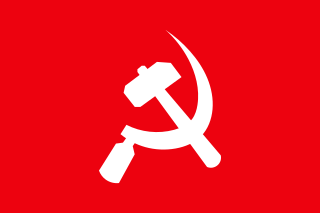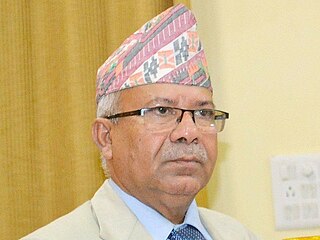Related Research Articles

The politics of Nepal functions within the framework of a parliamentary republic with a multi-party system. Executive power is exercised by the Prime Minister and their cabinet, while legislative power is vested in the Parliament.

The Nepali Congress is the largest social democratic political party in Nepal. As per the results of recent local election, Nepali Congress stands as the single largest party of Nepal in local levels. It is the current ruling party of Nepal since July 2021. With more than one million active members, the party remains the largest party in Nepal by membership and is the only mass based party in Nepal.

Pushpa Kamal Dahal, also widely known by his nom de guerre Prachanda, meaning "fierce", is a Nepalese politician who served as Prime Minister of Nepal from 2008 to 2009 and again from 2016 to 2017.

The Communist Party of Nepal , abbreviated CPN , CPN-Maoist Centre, CPN Maoist Centre, or CPN(MC), is the third largest political party in Nepal. It was founded in 1994 after breaking away from the Communist Party of Nepal.

The Communist Party of Nepal , abbreviated CPN (UML), is a communist party in Nepal formed in January 1991, merging the Communist Party of Nepal (Marxist) and the Communist Party of Nepal (Marxist–Leninist). It is currently the opposition party of Nepal..

The Communist Party of Nepal (Marxist–Leninist–Maoist), abbreviated CPN (MLM), was a minor communist party in Nepal. The party was as founded in 1981 by Krishna Das Shrestha. Initially known as the Nepal Marxist-Leninist Party, Shrestha had broken away from the Bagmati District Committee, which functioned semiautonomously, of the Communist Party of Nepal in 1969. Krishna Das Shrestha was the party president.

Madhav Kumar Nepal, is a Nepalese politician and former Prime Minister of Nepal. He served as Prime Minister of Nepal from 25 May 2009 to 6 February 2011 for nearly two years.

Communist Party of Nepal was a communist party in Nepal. It was formed on November 15, 2005, through the merger of the Communist Party of Nepal (Marxist-Leninist-Maoist) and the Nepal Samyabadi Party (Marksbadi-Leninbadi-Maobadi). The party was led by Krishna Das Shrestra (chairman) and Nanda Kumar Prasai.

Janamorcha Nepal was founded in 2002 as the mass organisation and electoral front of the Communist Party of Nepal. It was formed following the merger between the Communist Party of Nepal and the Communist Party of Nepal (Masal) when their respective fronts Samyukta Janamorcha Nepal and the Rashtriya Jana Morcha joined together on 10 July 2002.

Constituent Assembly elections were held in Nepal on 10 April 2008, having been postponed from earlier dates of 7 June 2007 and 22 November 2007. The Constituent Assembly was planned to draft a new constitution and therefore decide, amongst other things, on the issue of federalism. The number of eligible voters was around 17.5 million. The Constituent Assembly was originally set to have a term of two years.
Young Communist League, Nepal is the youth wing of Communist Party of Nepal (Maoist) (CPN-Maoist). The president of YCL is Ganeshman Pun and the general secretary of YCL is Dilip Kumar Prajapati. The Young Communist League (YCL) was formed by the CPN–Maoist at some point during the 'people's war' to support the revolution. Ganeshman Pun, chairman of the YCL, has stated that the League was reactivated in November 2006. According to him, the YCL "is a fusion of the Party's military and political character, and it is composed of PLA members who have an interest in politics." As the party's youth wing, its role is to "organise youth, be involved in events, conduct political awareness, and take part in development work as volunteers." Once the CPN-Maoist was proscribed, the YCL was also forced underground. After the April 2006 Jana Andolan and the subsequent over-ground role of the insurgents, the CPN-Maoist revived the YCL.

The Nepal Communist Party, abbreviated NCP is a defunct communist party of Nepal. It was founded on 17 May 2018, from the unification of two leftist parties, Communist Party of Nepal and Communist Party of Nepal. The unification was completed by the Party Unification Coordination Committee, after eight months of negotiation. The two predecessor parties subsequently dissolved, making way for the new united party. The party retained the electoral symbol of the CPN, the sun.

The Madhesi Jana Adhikar Forum, Nepal (MJFN), or the Madhesi People's Rights Forum, Nepal, was a political party in Nepal. It was initially not a political party as such but a political advocacy movement demanding ethnic self-determination rights with the formation of a Madhes autonomous region for Teraibasi people, an election system based on proportional representation, and the setting-up of a federal republic in Nepal. The MJFN includes former leaders of other political parties like the Nepali Congress and CPN (UML).

The first Nepalese Constituent Assembly was a unicameral body of 601 members that served from May 28, 2008, to May 28, 2012. It was formed as a result of the first Constituent Assembly election held on April 10, 2008. The Constituent Assembly (CA) was tasked with writing a new constitution, and acting as the interim legislature for a term of two years. 240 members were elected in single-seat constituencies, 335 were elected through proportional representation, and the remaining 26 seats were reserved for nominated members.
Jhakku Prasad Subedi is a Nepalese politician, belonging to the Communist Party of Nepal (Maoist). He is a teacher by profession.

The United People's Front of Nepal, abbreviated SJM, was the front of the Communist Party of Nepal, or CPN (UC).

Khadga Prasad Sharma Oli is a Nepalese politician and former Prime Minister of Nepal. He served three terms as prime minister from 11 October 2015 to 3 August 2016, from 15 February 2018 to 13 May 2021 as the first elected prime minister under the new constitution, and from 13 May 2021 to 13 July 2021.

Yogesh Bhattarai is a Nepali politician and a former Minister of Culture, Tourism and Civil Aviation. He was elected to the House of Representatives from Taplejung constituency in the 2017 general elections.

Communism in Nepal traces its roots back to the pro-democracy movement of 1951, and the subsequent overthrow of the autocratic Rana regime and the establishment of democracy in Nepal. The communist movement in Nepal has split into factions multiple times and multiple factions have come together into a single fold at times as well. It has a history of getting banned from open political discourse, as well as multiple instances of embracing guerrilla insurgency, most notably, the Maoist insurgency in the 1990s and early 2000s that led to the Nepalese Civil War, claiming at least 17,000 lives. After the Maoists and other main political parties formed a united coalition, launching a successful peaceful civil resistance against the dictatorial coup d'état by the monarchy, which resulted in the abolition of the monarchy and drafting of a new constitution affirming Nepal as a secular, federal, democratic republic striving towards democratic socialism, the two main communist parties of Nepal contested the first election according to the new constitution as a coalition, eventually leading to the unification of two parties with a strong majority in the federal parliament as well as six out of seven provinces of Nepal.

At the end of 2020, a major split in the Nepal Communist Party revived the Communist Party of Nepal, and the Communist Party of Nepal.
References
- 1 2 Bhuwan Chandra Upreti (2010). Nepal: Transition to Democratic Republican State : 2008 Constituent Assembly. Gyan Publishing House. p. 212. ISBN 9788178357744. OCLC 1024257290.
- ↑ Hoftun, Martin, William Raeper and John Whelpton. People, politics and ideology: Democracy and Social Change in Nepal. Kathmandu: Mandala Book Point, 1999. p. 119
- ↑ Whelpton, John. Nepalese Political Parties: Developments since the 1991 Elections
- ↑ Nepal Press Digest, Volume 39. Regmi Research Project. 1995. pp. 277, 369. OCLC 1759623.
- ↑ Nepali Times. Pact reaffirmed
- ↑ Kundan Aryal; Upendra Kumar Poudel, eds. (2006). Jana Andolan II, a Witness Account: A Report of Human Rights Violation by the King's Government During Nineteen Days of the Movement, April 6-24, 2006. Informal Sector Service Centre. p. 11. ISBN 9789994690404. OCLC 213928299.
- ↑ United Nations Mission in Nepal. EC registers 74 parties for CA election
- ↑ Spotlight. Transition . January 19, 2007. p. 7
- ↑ Nepal, Observation Constituent Assembly Election, 2008: Comprehensive Report. National Election Observation Committee. 2008. p. 115. ISBN 9789937207546. OCLC 302414811.
- ↑ The Himalayan Times. Maoists smooth the way for a jumbo CC
- ↑ eAdarsha.com. NCP's Standing Committee meet continues
- ↑ Khabarhub. NCP central organization departments formed
- ↑ SidhaKhabar. Prachanda-Nepal group protesting in Kathmandu today, procession from 9 places
- ↑ Headline Nepal. Massive power demonstration of CPN-Prachada-Nepal today
- ↑ Khulamancha. NCP Prachanda-Madhav Kathmandu-Protest